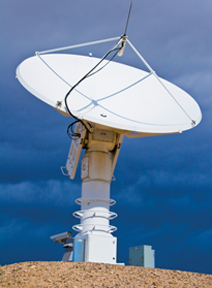
Over the past five decades Sandia has developed, fielded, and operated 140 satellite payloads without a critical mission system failure, making its satellite endeavors among the largest enduring programs at the Labs.
Sandia is now on the verge of a major program deliverable that has involved hundreds of people and hundreds of millions of dollars over the past several years.
“We are proud of our satellite efforts and their contributions to national security,” says Bruce Walker, director of Monitoring Systems and Technology Center 5700. “Many people from across the Labs, particularly from divisions 1000, 2000, and 5000, have contributed to these complicated programs that are built on past successes. The work they do continues to amaze me.”
Today’s systems, he says, draw on many unique Sandia competencies, including space system engineering, high-bandwidth data processing, advanced software development, thermal management, high-reliability software, and hardware engineering. Like other emerging technologies, the systems have grown in size, complexity, and mission importance with each new generation.
“The complexity and sophistication of the newest systems constantly challenge Sandia’s engineering and management talents,” says Mike Vahle, director of Systems Mission Engineering Center 5500. “Through the years Sandia has pushed the state-of-art in space-based instrumentation and ground-based command, control, and processing, which is why customers have continued to trust us with important projects.”
Current satellite programs have budgets that rival investments made in programs like MESA (Microsystems & Engineering Science Applications).
Role began with Vela program
Sandia’s role in space began with the Vela program of the 1960s, a result of a nuclear test moratorium of 1958 and the Limited Test Ban Treaty of 1963. Vela was designed to detect testing in the atmosphere and space. Los Alamos and Sandia national laboratories both had roles in Vela. Also, Sandia and Los Alamos jointly developed and installed atmospheric and space nuclear burst detectors and logic systems on Air Force space satellites.
After Vela was fully approved in 1961, Sandia became responsible for power handling, logic and data storage systems, ground checkout equipment, and computer analysis of data coming from detectors designed and built by LANL. In addition, for the later eight Vela satellites, Sandia designed and built the various optical detectors and optical burst locators that have become, with exponential complexity, the mainstay of the programs supporting the US Nuclear Detection System (USNDS) mission.
Following Vela’s successes, payloads on two other “bread and butter” satellite programs — Defense Support Program (DSP) and Global Positioning System (GPS) — employed hundreds of people throughout Sandia, Bruce says. Sandia and LANL designed payloads to be flown on both systems. For the GPS satellites, Sandia continues to design the sophisticated optical radiometers, power systems, and data processing logic as well as radiation-hardened, large-scale integrated circuits. Sandia also provides the essential payload testing, system integration, launch support, and orbital technical systems for these payloads.
Four decades, 23 DSP launches
The DSP satellite systems have flown for nearly four decades with 23 launches; the first was launched in November 1970 and the last in November 2007. The DSP USNDS packages, which incorporated novel, state-of-the-art designs, leveraged other space-based designs and have provided nuclear burst detection, nuclear burst location, and various space and Earth environment monitoring data.
In support of space-based resources, large-scale ground-based processing systems — designed, built, and maintained by Sandia — have provided the essential interface for customers and analysts in numerous agencies and departments.
Through the years Sandia has been involved in numerous satellite initiatives. For many, Sandia added experimental and operational packages to existing payloads. In the case of the MTI (Multi-Spectral Thermal Imager), Sandia was responsible for the entire satellite, doing all the design, assembly, system integration, and construction work, as well as supporting launch of the satellite and providing integral parts to the ground processing system.
Complex systems
All of these projects involved the development, deployment, and operation of very complicated systems that have extensive hardware and software elements both on the ground and on orbit. That complexity has implications for the engineering administrative and management talent required, the underlying physical and information technology, the extraordinary level of reliability required, and the need for extended operations in very extreme environments.
Mike notes that current projects require sophisticated equipment. To meet these needs two buildings were renovated. A Class 100 clean room integration facility was created in one building while another building was modified to create a facility for the development and testing of large, high-performance computing systems.
Jerry McDowell, VP of Defense Systems & Assessments Div. 5000, says satellite sensor programs are “vital to Sandia’s future.”
“The paradigm of strategic national security is changing, and space will grow in importance as a leverage point for our nation’s enduring security,” Jerry says. “Success with these programs demonstrates that Sandia’s engineering, science, and technology base is strong and relevant to the new challenges we face and that Sandia can deliver products.
“Remote sensing and verification is the new face of Sandia. Staff from across the Labs combine talents from multiple disciplines to deliver real capability for decision makers. It’s an exciting time in the Defense Systems and Assessment SMU [Strategic Management Unit], and I applaud all Sandians who are forging a ‘new order for the ages’ by their successful work on our ongoing sensor programs.”